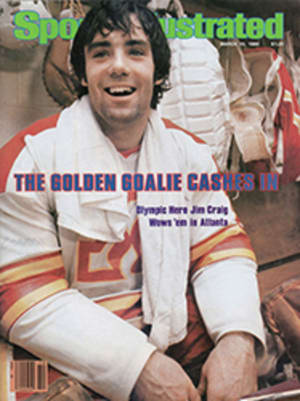
The shrink of the drink
They might all stretch out on their backs, point to spots just below their navels and mentally try to move their brains down into their abdomens. Or, they might make animal noises—oinks and squeals and growls and grunts. Or, they might close their eyes and transport themselves to a beach in the Caribbean or into the future. They are not into est, TM or primal scream therapy. Their thing is swimming for the University of Iowa and they are preparing themselves to win.
For most of the '60s and '70s the Iowa swimmer was seen as this poor guy dog-paddling along in the wake of his opponents, hoping he would reach the wall before drowning. The Hawkeyes finished last or next to last in the Big Ten for 10 straight years between 1967 and 1976. Faded and nearly forgotten were the triumphs of the past: Iowa's Wally Ris winning gold medals in the 100-meter free and 800-meter free at the '48 Olympics and the butterfly stroke being invented in the Field House Pool in 1934.
But this season Iowa has won four out of four relay or invitational meets and all eight of its dual meets, including a 79-34 victory over defending NCAA-champion California and a 76-37 defeat of perennial Big Ten power Indiana.
Most of the credit for the turnaround goes to Glenn Patton, who took over as coach in 1976. But the Sigmund Freud Trophy must go to Dr. Eugene Gauron, the swimmers' shrink, who has proved that a team can profit from having both a head coach and a head coach.
"The biggest untapped area in athletics is mental training," says Patton, "and before the 1980s end, I think every major sports university is going to have a full-time psychologist on its staff."
Mental training seems to be almost as important to the Iowa swimmers as the time they spend in the water or lifting weights. Gauron, 44, an Iowa psychology professor with a soothing voice, meets with them three times a week and attends all their meets. He receives no pay—though the athletic department gives him his traveling expenses—but likes working with athletes so well that he is now holding sessions with Iowa's women golfers as well.
"It's one of the most creative things I've done in my life," Gauron says. "It's an adventure in the exploration of human potential."
Gauron tries a great variety of things at the meetings, which sometimes resemble the group-therapy sessions he supervises elsewhere around Iowa City. Recently, for instance, he read aloud from a book about the samurai, who used mental training a thousand years ago. Then he told the swimmers to write papers on how they will feel when—not if—they win the Big Ten Conference meet at Michigan this weekend. During another session he showed them a photo of the Michigan pool, so they could more easily visualize where they are going to outswim the competition.
"If you think, 'All right, this guy is very good, he's going to beat me,' then that's it, he's going to beat you," says Gauron. "If you say to yourself, 'I'm very good. I'm an excellent swimmer. I can beat this guy,' that's what will happen, too. Of course, it depends on the swimmer's talent. There's got to be some reality element involved. Then, within those confines, you can be confident."
Gauron has read every book he could find on sports psychology, but he hasn't consulted the psychologists who have worked with the Indiana basketball, California swimming and Colorado State skiing teams. He has just dived in and developed his own techniques or adopted ideas he's found in the meager literature on sports psychology available in the U.S. Unfortunately, the results of extensive psychological experimentation done in the U.S.S.R. and East Germany are largely unavailable for study.
Gauron is fond of telling the Hawkeye swimmers how mental training has helped him in his own athletic pursuits: tennis, swimming, cross-country skiing, bowling. He will have them close their eyes and mentally scan their bodies, looking for—and then relaxing—areas of tension. At the start of the season, shortly after Patton had asked Gauron to join his staff, some of the swimmers snoozed when they should have scanned, but now most of them have learned to relax without dropping off.
Patton thinks the psychologist's most important contributions come just before a meet. Because their sessions with Gauron have made the swimmers acutely sensitive to their state of mind and body, they can describe to Gauron in considerable detail how they're feeling. One might say his long intestine seems to be tied in a square knot, another might feel as if he's facing something as tedious as a lecture on gladioli. Gauron then gives them mental exercises to lift or drop themselves to that ideal point where they are both calm and psyched up.
Sometimes Patton and Gauron can read the collective psyche of the team, as they did before the season's first dual meet against Indiana. Before Gauron, a typical Patton premeet pep talk for such an occasion would have been, "O.K. now the key is the 400 meters. We've got to win that first one." This season, he turned the petrified swimmers over to Gauron, who told some corny jokes and led a chorus of animal noises.
"I think I'd have been scared to death if Gene Gauron hadn't shown up and relaxed us," freshman backstroke star Tom Roemer told the Des Moines Register after the meet. "I was afraid it might be like my first meet as a sophomore in high school when I got disqualified on false starts. But he told some jokes, made us laugh and did different things to ease the tension. When the meet started I was more relaxed than I'd ever been before."
Iowa not only won by 39 points but also its swimmers achieved 16 lifetime-best performances, including a 1:52.63 by Roemer in the 200-yard backstroke. It was only the 10th dual-meet loss in 23 years for Indiana Coach Doc Counsilman, who got his Ph.D. in exercise physiology at Iowa.
Patton, 37, a Division II All-America distance freestyler at Springfield College and national junior-college coach of the year three straight years at Alfred (N.Y.) Tech before coming to Iowa, is what every coach claims to be but often isn't, a "tireless recruiter." Most every night at their home in Iowa City's Mosquito Flats section—it's close to the Iowa River—his wife Joyce sews as Patton runs up a mammoth phone bill talking to prospects.
He didn't have much luck when he first arrived and had to pack his team with foreigners, such as Olympic free-stylers Bent Brask of Norway and Brett Naylor of New Zealand, who takes his practice laps wearing three women's swimsuits—in drag to increase the drag. Each recruiting crop has been better than its predecessor, and the current freshman contingent features Roemer, an Iowa-bred predental major who was sought by Indiana, USC, Arizona and Tennessee. He is already the school record holder in the 100-and 200-yard backstroke and the 200-yard individual medley.
Patton figures the Hawkeyes have enough talent to fight it out with Indiana and Michigan for first place in the Big Ten meet, where individual performances will count more heavily than the team depth that served Iowa so well in dual meets. Patton also predicts a 12th-place finish for the Hawkeyes at the NCAAs on March 27-29 at Harvard—maybe even 10th if Gauron turns the swimmers into samurai.
In addition to Iowa's improving record, recruiting has been helped by last summer's $400,000 renovation of the Field House Pool, which was built during the Coolidge administration. Patton, who is cocky enough to hand out golf tees imprinted with "Patton Pending #1" and not the sort of person to understate anything, says Iowa now has the fastest pool in the Big Ten.
Patton loves to experiment. He has one of his backstrokers, Steve Harrison of England, stay underwater for three-quarters of the pool's length at the start of his races, because Patton thinks he swims faster than if he stays on the surface. He believes that U.S. coaches, himself included, have been overworking sprinters, and he has cut their weekly mileage from as much as 70,400 yards to as little as 21,120. For the Big Ten meet and the NCAAs he will outfit his swimmers in nylon-mesh peekaboo suits.
"We did some studies on them," he says. "Looked at them underwater and compared them to other suits. The water and air flow in and flow right out. No bagginess. I think it's the fastest suit in the world."
In searching for an edge, Patton has not overlooked the University of Iowa Hospital, the largest school-owned teaching hospital in the world. The cardiology department checks his swimmers before, during and after the season.
And at the school's Hydraulics Research East Annex, across the Iowa River from the main campus, Patton and Dr. Edmund Burke, who is working at Iowa on a grant from the National Institutes of Health, have latched on to an environmental flume usually used for hydraulic tests. They convinced the school to put in a glass wall and make some other adjustments so that Hawkeye swimmers can climb into the 60-foot-long tank and battle against currents flowing at as much as 8½ feet per second, sort of like salmon swimming upstream to spawn. While a swimmer struggles to stay in the same place in the flume—in front of the glass, Patton hopes—various tests and movies can be made to help analyze his stroke and position in the water.
"Since I've come to Iowa I've felt that we could duplicate here, with our swimmers, what the East Germans and Russians are doing," says Patton. "Physiological testing, psychology testing and the feeding of this information into computers and getting readouts."
Patton is nothing if not a big thinker. "When I'm 60 years old I hope that I'll be looked upon as one of the top coaches in the world"—and with the help of science, he just might reach that goal. Certainly the employment of a psychological coach is already paying off.
Some of the mental training has even rubbed off on Patton, who sits in on all of Gauron's sessions. "It's sort of weird," says sophomore freestyler Scott Wisner. "When I first met Coach Patton he would be pacing up and down the pool deck at meets. And then for Indiana, our first meet of the year and the biggest of his career, he was real calm and confident. It was a real turnabout."
Gauron himself seems to be the sort of fellow who could amble around the battlements of a besieged fort, making small talk with the soldiers while shells fall all about them. Before the Iowa-Iowa State meet one of his swimmers went to him and said, "I wanted to come over and sit next to our center of calmness."
But Gauron is human. His wife Pat reports that he is a maniac at Hawkeye basketball games, so much so that a friend bought him a scorebook to keep him busy and calm him down.
PHOTO
RICH CLARKSON
It's a drag, but Naylor practices in three women's suits.
PHOTO
RICH CLARKSON
The doctor has a hand in the swimmers' success but can't get a grip on himself for basketball.
PHOTO
RICH CLARKSON
Gauron helps the Hawkeyes win by transporting their minds to the Caribbean—or into the future.
PHOTO
RICH CLARKSON
Like salmon going upstream, swimmers fight the flume, spawning a new way to analyze strokes.
PHOTO
RICH CLARKSON
Patton's an experimenter—and exaggerator.

